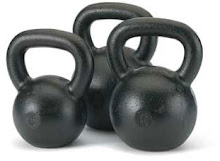Kettlebell Training for Power Endurance
Most sporting events revolve around your ability to create explosive movements over an extended period of time. This athletic quality is known as power-endurance. Training for power-endurance can be absolutely grueling; however, the athlete that possesses the greatest amount of power-endurance usually goes home the winner. Kettlebell training is relatively new in the world of sports performance enhancement. However, if there is one training tool for improving power-endurance, kettlebells are it. Kettlebell training traditionally revolves around modified Olympic lifting variations performed for high repetitions. It's this combination of high repetitions and modified Olympic lifts that make kettlebell training ideal for creating incredible amounts of power-endurance. What is it about this combination that makes kettlebell training so effective
Olympic lifts and their variations, by their very design cannot be performed slowly. Snatches, Cleans and Jerks must be executed quickly or not at all. By combining this quick lifting protocol you essentially train your body to produce high rates of power for an extensive time period
Kettlebell Clusters:
Kettlebell Clusters involve performing 1 repetition every 20 seconds for a set period of time. To spice things up even further I often rotate the drills that are performed every rep. For example, on the first rep you Snatch, rest 20 seconds and then Clean, rest another 20 seconds and High-Pull. A great way to work Kettlebell Clusters is by training with a partner. You each call out the drill that your partner is to perform for their next rep. This just adds some chaos and a lot of fun to the workout. It also becomes very competitive with each partner trying to outdo the other. Just make sure to pick drills that are explosive and performed quickly as well as within the skill set of your partner.
So One Minute Of Kettlebell Clusters Would Look Like This:
- 1 Kettlebell Snatch - 20 seconds rest
- 1 Kettlebell Clean and Jerk - 20 seconds rest
- 1 Kettlebell Push Press
Repeat for the desired amount of time.
Kettlebell Couplets:
Kettlebell Couplets involve alternating a full-body ballistic movement with a fundamental bodyweight drill that stresses different musculature or opposite movement patterns. This allows one set of muscles to recover while the others are working overtime. Working in a descending rep scheme is a great way to train Kettlebell Couplets, simply because you can see the light at the end of the tunnel and as you near the end of your set you'll be fired up and hasten your performance. It's a great idea to time yourself during some of your favorite Kettlebell Couplets and try to beat that time when you visit that workout again. Here are a few Kettlebell Couplets that are guaranteed to improve your power output. Alternate each exercise until all sets of each drill are complete. Keep rest periods short and work to improve your time when you perform this workout again.
- A1) Kettlebell Swing - 6, 5, 4, 3, 2, 1
- A2) Pushups - 6, 5, 4, 3, 2, 1
- B1) Kettlebell Snatch - 5, 4, 3, 2, 1
- B2) Dips - 5, 4, 3, 2, 1
- C1) Kettlebell Jerk - 5, 4, 3, 2, 1
- C2) Pull-ups - 5, 4, 3, 2, 1
Kettlebell Complexes:
One of the greatest features of kettlebell training is the ability to link and combine distinct movements into one continuous set. The unique shape of the kettlebell allows you to transfer from one ballistic drill into another without a hesitation. Complete the prescribed repetitions of each drill before moving unto the next. Don't stop working until each drill is complete. As you fatigue, drop your repetitions to ensure fast, high quality movement.
Complex #1
- A1) Kettlebell Snatch - 5, 3, 1
- A2) Kettlebell Clean -5, 3, 1
- A3) Kettlebell Swing - 5, 3, 1
Complex # 2
- B1) Kettlebell Push-Press- 5, 3, 1
- B2) Kettlebell Jerk - 5, 3, 1
- B3) Thrusters - 5, 3, 1



No comments:
Post a Comment